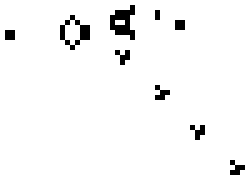A cellular automaton (pl. cellular automata, abbrev. CA) is a discrete model of computation studied in automata theory. Cellular automata are also called cellular spaces, tessellation automata, homogeneous structures, cellular structures, tessellation structures, and iterative arrays. Cellular automata have found application in various areas, including physics, theoretical biology and microstructure modeling.
-On Wikipedia.
The cellular automaton is a simulation that got populazired throught Conway's game of life where it consists of regular grids of cells or a matrix where it has a finite amount of states and each cell as a defined amount of rules based on it's neighbors relative to the cell's position and with such simple rules complex and emergent behaviors could occur.
The Game of Life, also known as Conway's Game of Life or simply Life, is a cellular automaton devised by the British mathematician John Horton Conway in 1970. It is a zero-player game, meaning that its evolution is determined by its initial state, requiring no further input. One interacts with the Game of Life by creating an initial configuration and observing how it evolves. It is Turing complete and can simulate a universal constructor or any other Turing machine.
-On Wikipedia.
The game of life has simple rule sets descrived:
- If a cell neighbourhood has less than two live cells, all cells die;
- If the alive cell has two or three live neighbours, the cells remain;
- If the cell neighbourhood has more than three cells, the singular cell dies;
- If a dead cell has exactly three alive cells in the neighbourhood, it becomes a live.
A falling-sand game is a genre of video game and a sub-genre of sandbox games which typically utilize a two-dimensional particle or cellular automaton based game engine to simulate various materials interacting in a sandbox environment. In falling-sand games, the user can interact with (e.g. place and remove) particles on a canvas which can interact with other particles in various ways, which can lead to complex emergent behaviour. As sandbox games, they generally have an emphasis on free-form gameplay, relaxed rules, and minimal goals.
-On Wikipedia.
The falling sand game is a type os cellular automaton where as the game of life each set of cell as a defined behavior when in contact with diferent cells.
The main objective of this simulation is to recreate the behaviors of different material types within a grid-based environment. A simple action, like setting fire to water, can trigger cascading effects across large quantities of materials. These interactions create a dynamic and engaging experience, where players observe emergent physical phenomena, such as evaporation, flow, and chemical reactions.
In this game, sand behaves like a loose granular material. When the cell below a sand particle is empty, the particle "falls" by swapping places. If the space below is occupied, the sand checks neighboring cells to move diagonally, mimicking gravitational behavior.
Water behaves similarly to sand in its falling motion, but when it hits the ground, it attempts to flow left or right. The water particles randomly move into empty horizontal spaces, simulating fluidity.
Other complex interactions include:
- Chemical reactions such as soap bubbles and acid reactions.
- Heat-based interactions like water evaporating or lava being extinguished.
- Inertia and momentum, where water flows to fill available space in a container, and gases spread or liquids cascade based on physical properties.
There are diverse footage took from the simulation, feel free to get a look into it:
Note
In the sand, there is even the behavior of inercia and collision.
- Soap and acid reactions:
- Lava, fire, and water interactions:
- Sand in motion, reacting to inertia and collisions:
- Water physics, with inertia and momentum-based behavior as water fills available space:
The project uses the MiniLibX using the X11 Window system in the Linux Operating System, after the instalation of all dependencies you should do as required:
- Clone the repository;
git clone https://github.com/gecarval/Falling-Sand.git- Move to the folder;
cd Falling-Sand- Compile the project;
make- execute the program.
./render| BUTTON | ACTION |
|---|---|
Q |
Empty |
W |
Sand |
E |
WetSand |
R |
Stone |
T |
GunPowder |
Y |
Soap |
U |
Wood |
I |
Iron |
O |
Rust |
P |
Glass |
A |
Water |
S |
Lava |
D |
Oil |
F |
Acid |
G |
Fly |
Z |
Fire |
X |
Oxygen |
C |
Hidrogen |
V |
Propane |
B |
Steam |
N |
Missil |
, |
decrease brush size |
. |
increase brush size |
LMB |
activate brush |
RMB |
deactivate brush |
Esc |
Exit |
[ |
increase speed |
] |
decrease speed |
1 |
on/off 3Dcube |
2 |
on/off falling sand |
Space |
clear screen |














